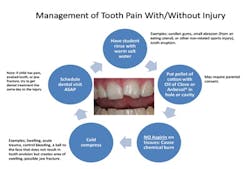Digital Radiology: Tips for expanding technology
by Sonya L. Prater, RDH, BS, FACE
Some people make things happen, some watch things happen, and some don’t know anything happened.” From “The Power of Purpose,” by Richard J. Leider
I don’t know about you, but I’d much rather be among the elite few who make things happen. In this ever-changing technological era, it takes dedication to keep up. How much do you value quality patient care? Some of you may be thinking that if this article is about radiology, why the motivational speech about quality care? Because the things we value shape the way we practice dentistry. If we value a paycheck, we go into the office, do our job, and leave with little thought of going the extra mile. If we value patient care, we try every possible way to make sure patients in our care understand their overall dental condition, and we provide nothing short of excellence in treating any areas of concern. Of course we are all working for a paycheck, but we all have a driving force as well. Some work in the realm of excellence, and some just want it reflected in their paycheck.
Technology has truly changed the way we see the world. Just as technology has become a welcome guest in our homes, it has also become an essential component in the dental office — digital technology is now on the forefront of the “total package” dental office. We need to offer more comfort, attention, and technology to our patients. Those are the things that make people feel special and assure them that we are cutting edge. Digital radiology dentistry embraces the transition from the practice of fixing teeth to changing lives. People are beginning to accept responsibility for their oral health, and educating them has never been easier. Although you as the dental professional may be the only trained eye in the room, it is not uncommon for patients to comment on an abscess or “bombed out” tooth that is very evident on the radiograph. A lot of what we show people is fairly obvious when it is pointed out to them. They may not know what they are looking at, but with an explanation, patient knowledge and provider credibility both increase. Patient acceptance of dental treatment skyrockets when they can visually comprehend the “why” behind a treatment recommendation (see Figure 1). This is much like a quote in the movie “Field of Dreams” — “If you build it, they will come.” Most people are very visual, and if they see it, they get it. We all want to be informed before making any decisions, so why should we practice dentistry any differently?
One of the biggest obstacles people face, no matter what their profession, is ignorance. People don’t like change because they generally don’t understand it. Dentistry has come a long way and we need to embrace this evolution. There is no reason to expect modern technology to affect dentistry in a negative way, except for those who fear change. By understanding a few simple facts one can easily see how revolutionary this change really is. It takes time and effort to stay cutting edge, and you can be sure that progress will not wait on you. Put the resources available to you to good use.
Figure 1: Using digital photography and digital radiography together allows the patient to see what their teeth really look like and how you formulated a diagnosis.
Radiographs, commonly referred to as X-rays, have been around since the late 1800s. However, digital radiography has been around only since 1987. In dental hygiene school we all became familiar with the name William Conrad Roentgen. We probably didn’t pronounce it correctly, but we knew what the name was associated with — radiology. Do you know why radiographs were quickly given the shorter name of X-rays? It goes back to a simple mathematical reason. X is the symbol for anything unknown. In this case, the unknown is a type of radiation, specifically electromagnetic radiation.
When first discovered, dental X-rays took about 25 minutes to expose a single film. Can you imagine taking a full-mouth series today if it took that long? How productive do you think you would be, maybe seeing two patients a day? Obviously we would never do that. Not to mention, our patients probably wouldn’t allow us to do that. I’m sure you can relate, and I can’t tell you how many times I’ve heard, “I don’t want any unnecessary X-rays taken today.” In my thoughts I respond, “Well, you better be glad you came in today because that’s all we did yesterday, take unnecessary X-rays!” One of the biggest advantages to digital radiology is the amount of radiation required to expose an image. It is about 70% less exposure than conventional technology. I still hear the occasional comment about limiting the number of X-rays, but people are realizing that radiographs are not taken just for the fun of it and that newer technology has its advantages.
As I mentioned earlier, the dawn of the digital radiology era was in 1987. The mastermind behind this new technology was Dr. Francis Mouyen. He developed a way to use fiber optics to break down a large X-ray image into smaller pieces and store them on the computer. In simple terms, a sensor (in place of film) captures the image and transmits it to a computer where it can be seen almost instantly. Traditionally, we had to expose the film, send it through the processor in the darkroom, and wait five to seven minutes for the images to be developed and dried. In my 15 years of experience in the dental office, the “red light” in the darkroom never worked, thus making opening the film packet difficult and finding the film’s entrance into the processor even more difficult. Also, the X-ray mounts were less than satisfactory, to say it nicely. Once they were out of the processor, the films were ready to be mounted. In my experience, the office usually ordered the cheap mounts, and it not only took forever to get the films in their proper place, but they often fell out in the chart. I don’t know about you, but I didn’t have the time or energy to label each film to know which radiographs were incomplete.
Digital technology has made dentistry more comfortable, faster, and quite simply, better! After getting a taste of digital technology and how much more efficient it is, traditional radiology seems very bland! Everyone is always looking for bigger and better. We have high definition televisions, so now our old televisions don’t seem very clear. Being able to enlarge images, change contrast, colorize, and transfer images via e-mail sets digital radiology apart from traditional methods. I’ve never been much of a traditional person. The tradition around my house is to do it differently the next time.
Being able to explain procedures to your patients with pictures of their old amalgam fillings (see Figure 2), radiographic images of the bone surrounding each tooth, and 3-D images of how and where implants will be placed (see Figure 3) makes your explanations much more effective than if you simply spoke to them. If they can’t visualize the “why” behind a treatment, then they are less likely to accept the recommended treatment, no matter how badly they might need it. They must find value in their decision. If they value health and prevention at all, they will value the information you provide, and they will appreciate the time, effort, and expense you took in making sure they make a well informed decision.
Figure 2: The digital picture shows an old amalgam filling in #21 with fracture lines running down the tooth although the fractures remain undetected in the radiograph. The radiograph alone may not be adequate evidence for the patient that this tooth needs a new restoration.
If digital radiology is not currently being offered in your office, push for it. The benefits far outweigh the cost of the equipment. You have no real edge over your competitors without it. More than likely that means you are technologically deficient in other areas and provide only basic dental care. If you have access to a digital system, learn it. Work smarter, not harder! Some examples of digital radiology systems are Dexis, Kodak, Schick, Suni, and Digirex. 3-D is a much more precise imaging system that is extremely beneficial in the areas of orthodontics, endodontics, and implant placement. The types of dental radiographs offered by digital technology are periapicals, bitewings, panorex, CAT scan, and tomographs.
Figure 3: Dentists/surgeons can use this image to project implant placement as well as the size of the implants and how many to place.
To sum it up, it’s not difficult to weigh the benefits of going digital against conventional methods. Cutting edge technology gives patients a visual indication of your thoroughness and attention to detail. It also increases the value of the services that dental professionals provide. A willingness on the part of the dentist to invest in such technology means that patients will receive better care and a more thorough evaluation. In their minds, technology equates to quality. Digital radiology will improve patient care and provide a clearer diagnosis for the dental professional. I’ve never had much patience for procrastination, so my advice to those who are scared to learn something new is simply this, to borrow a popular slogan — JUST DO IT!
Sonya Prater, RDH, BS, FACE, is practicing full time in Savannah, GA, in a very progressive dental office, Beyond Exceptional Dentistry. The practice specializes in highly complex and reconstructive TMD cases. She is also a faculty member/instructor for The Niche Practice Seminars, the hygiene consultant for KOMET USA, and seizes every opportunity to further her education in as many areas as possible.
Here are some points comparing the two ways of taking radiographs:
Traditional- The image is too small and can’t be enlarged
- The image is not always clear
- The color or contrast cannot be changed
- Full process is time consuming
- Chemicals for processing are expensive, must be disposed, and the processor must be cleaned
- Films can discolor over time, especially if processed improperly
- Incipient decay cannot be detected easily — by the time we notice it, the tooth needs a filling
- Endodontic treatment — we are unable to see additional canals which can make the procedure time consuming
- Implant placement — it is difficult to determine bone density levels, thus putting the success of the implant at risk
- There is the ongoing cost of chemicals, film, mounts, and more
- The image can be enlarged on the screen
- The image is clear but can be clarified even more
- The color or contrast can be changed
- The process is much quicker, which allows us to spend extra time in patient education
- We can print out the picture, e-mail it, or save to a CD for the patient’s convenience
- There are no harsh chemicals or processor to deal with, and the image is transmitted directly to the computer
- The image can be seen virtually instantaneously, and if it is unacceptable it can be replaced in about two seconds
- Approximately 70% less radiation is needed compared to traditional “D” speed film
- It adds value to the overall patient experience
- Endodontic treatment — we are able to see additional canals and treat them more effectively and efficiently, which reduces the possibility of re-treatment
- Implant placement — this is much more precise than conventional, thus requiring less time for the procedure





